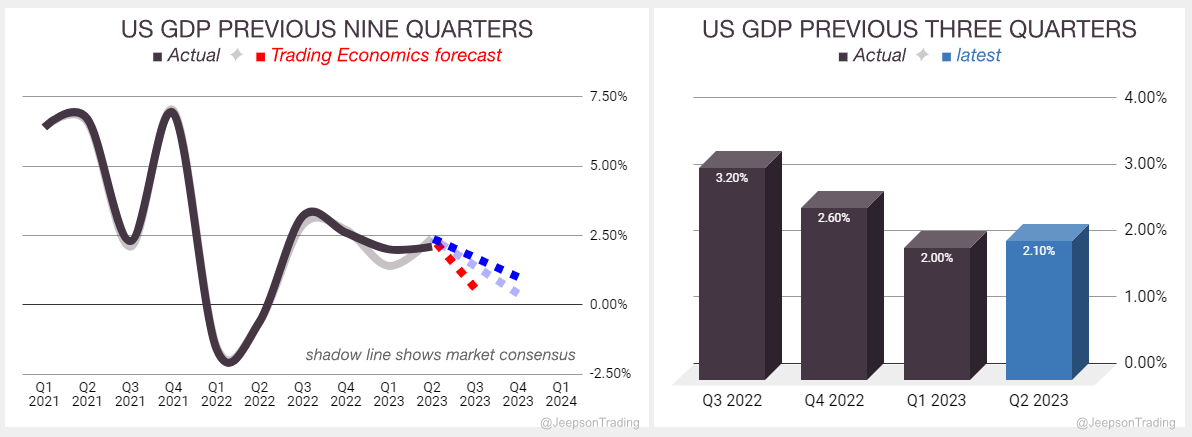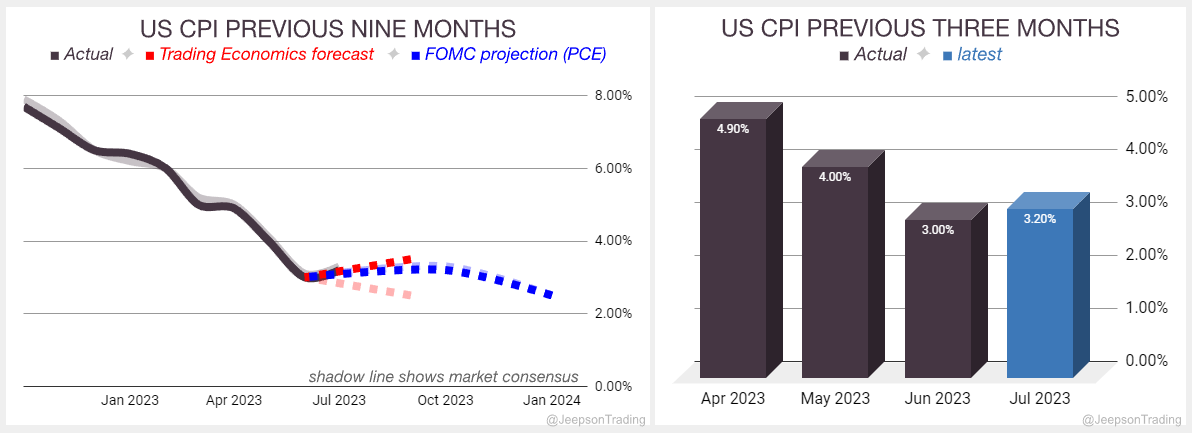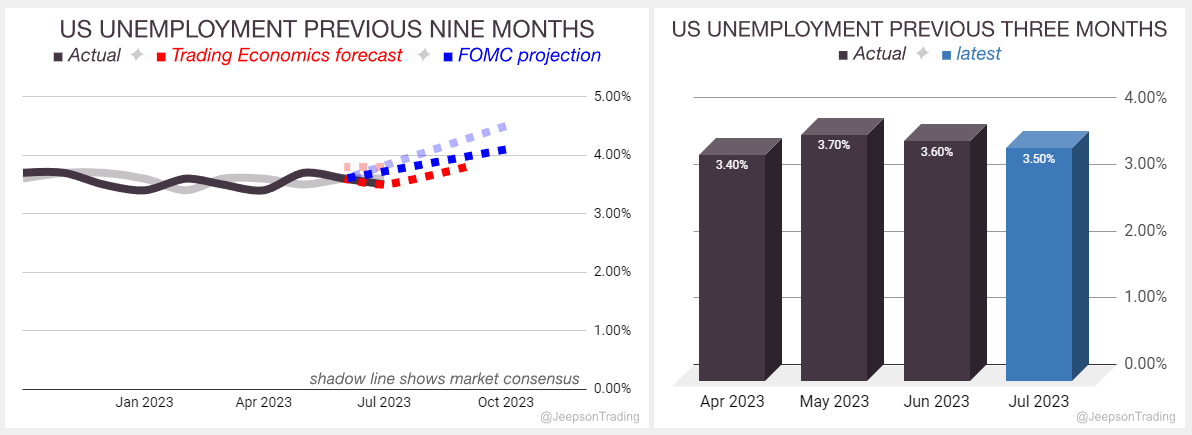US Dollar Currency Report AUGUST
DERBYSHIRE GB / AUGUST 31st, 2023 - Updated with fresh GDP estimate which falls below expectations. Next update after labour report on Friday, September 1st or before if any significant event occurs.
US Dollar Currency Report Summary
The US interest rate is anticipated to be held at its current high level for a lengthy period which is likely to lead to reduced or deferred borrowing. This suggests a pessimistic outlook for the US economy and may apply upward support to the value of the dollar.
US GDP is projected to deteriorate to 0.6% in Q3 after it missed expectations in Q2 and suggests a pessimistic outlook for the US economy and may apply some downward pressure to the value of the dollar as a low GDP could see the Fed relax their hawkish stance.
US CPI is projected to remain stable around 3.2% which was achieved in July as it slightly beat expectations and suggests an optimistic outlook for the US economy and may apply downward pressure to the value of the dollar.
US unemployment is projected to slightly deteriorate to 3.8% this quarter although it slightly beat expectations in July and suggests a cautiously optimistic outlook for the US economy and may apply some downward pressure to the value of the dollar.
The monetary-policy-hold narrative is likely to apply indifferent pressure to the value of the dollar.
The war in Ukraine will at times cause risk aversion and may lead to increased foreign investment in the bond market and apply upward support to the value of the dollar.
The China-US Trade war narrative is likely to apply upward support to the value of the dollar.
Monetary Policy
The Federal Reserve (Fed) Federal Open Market Committee (FOMC)
The Federal Reserve is the central bank of the United States. The Board of Governors, which has seven members, sets discount rates. The Federal Open Market Committee (FOMC), which has 12 members, sets the levels of central bank money and the federal funds rate. The FOMC members include all members of the Board of Governors, the president of the New York Fed, and four presidents from the remaining eleven Reserve Banks on a rotating basis.
The July meeting matched expectations with a 0.25% hike of the Fed Funds rate setting it at 5.25%-5.50% which is up from 5.00%-5.25% and the pause in June
The latest rate now matches the Trading Economics Q3 ‘23 forecast of 5.50% which they also identify as the peak
Over the previous three years, since the start of 2020, the interest rate has been trending up with a low of 0.25% and a high of 5.50%. Over the previous six months, the rate has climbed at a slower pace.
The next meeting is due on Wednesday, September 20th.
The Federal Open Market Committee‘s July statement summarised:
The economy is expanding at a moderate pace, with strong job gains and low unemployment
Inflation remains elevated.
The banking system is strong, but tighter credit could slow the economy
Rates will remain steady for now but will be adjusted if necessary
Sources: Federal Reserve, Trading Economics, FXStreet
FOMC Projections
The FOMC revised the projections at their June meeting and will update them again at the September meeting.
Projections of change in real gross domestic product (GDP) are percent changes from the fourth quarter of the previous year to the fourth quarter of the year indicated.
Economic Data
Gross Domestic Product (GDP)
In the US, GDP Growth Rate measures the yearly change in the price of goods and services purchased by consumers.
Second Q2 ‘23 estimate fell short of expectations coming in at a 2.1% annualised expansion, up from 2.0% in Q1 ‘23.
The latest report is above the FOMC 2023 change in real GDP forecast of 1.0% (revised up from 0.4%) and far above the Trading Economics Q3 ‘23 forecast of 0.6%.
Over the previous nine quarters, GDP has been trending down with a low of -1.6% and a high of 7.0%. Over the previous three quarters, GDP has been continuing to fall.
The final estimate Q2 report is due on Thursday, September 28th.
Sources: Bureau of Economic Analysis, Trading Economics, FXStreet
Consumer Price Index (CPI)
Inflation in the US is measured with the Consumer Price Index (CPI) which measures the yearly change in the price of goods and services purchased by consumers.
July ‘23 report slightly beat expectations coming in at 3.2% although is higher than the 3.0% in June ‘23.
The latest report now matches the FOMC 2023 PCE forecast of 3.2% although Trading Economics are less optimistic with a Q3 ‘23 forecast of 3.5% (previously 2.5%).
Over the previous nine months, CPI has been trending down with a low of 3.0% and a high of 7.7%. Over the previous three months, CPI has continued to fall although recently stalled.
The August report is published on Wednesday, September 13th.
Sources: Bureau of Labor Statistics, Trading Economics, FXStreet
Labour
Unemployment in the US is measured as the number of people actively looking for a job as a percentage of the labour force.
July ‘23 report slightly beat expectations coming in at 3.5% which is also slightly better than the 3.6% in June ‘23
Nonfarm payrolls stayed similar at 187K from 185K although that was significantly revised down from 209K
The latest report is below the Trading Economics Q3 ‘23 forecast of 3.8%.
Over the previous nine months, unemployment has been moving sideways with a low of 3.4% and a high of 3.7%. Over the previous three months, unemployment has continued to move sideways.
The August report is due on Friday, September 1st.
Sources: Bureau of Labor Statistics, Trading Economics, FXStreet
Market Influences
Monetary Policy Hold
As inflation in the US stabilises, the Fed now intends to hold rates steady. This makes borrowing less risky although it remains expensive. This could improve the outlook for growth, increase the appetite for stocks, and reduce the demand for the dollar as a safe haven.
Russian Invasion of Ukraine
The war is having a detrimental effect on the global and US economy by causing higher energy prices, higher food prices, higher inflation and is impacting economic growth.
2021: 92,000 Russian troops are amassed at the Ukraine border and President Putin proposes a prohibition of Ukraine joining NATO which is rejected.
2022: On the 21st of February, President Putin ordered Russian forces to enter the separatist republics in eastern Ukraine and announced recognition of the two pro-Russian breakaway regions (Donetsk People's Republic and Luhansk People's Republic). NATO applied sanctions and scaled them up as the war progressed. Ukraine mounted a counter-offensive which regained lost territory and as winter arrived, a stalemate began.
2023: Russian began a new offensive in January although gained little ground. In early June, Ukraine began its counteroffensive although progress has been slow even as Russia faced mutiny from the short-lived Wagner rebellion.
China-US Trade War
The trade war is having a detrimental effect on the global and US economy by causing higher prices for consumers, increased uncertainty for businesses, disrupted supply chains, job losses and is impacting economic growth.
2018: President Trump imposed tariffs on Chinese goods in an effort to reduce the trade deficit and promote domestic manufacturing. China retaliated with tariffs of its own. Negotiations are ongoing to resolve the trade dispute.
2019: Reports showed that the trade deficit increased to record levels in 2018 and the situation escalated through rhetoric. China was accused of currency devaluation (which would make exports more attractive) although the IMF rejected the claim. Negotiations continued throughout the year and a tentative deal was proposed in Q4 which aimed to improve relations and repair the damage that had been caused to both economies as a result of the trade war.
2020: A deal called Phase One was signed at the beginning of the year although the trade targets appeared unrealistic and were missed by year end.
2021: President Biden takes office and reviews the Phase One deal with ongoing talks throughout the year.
2022: The WTO declared the Steel and Aluminium tariffs to be in breach of rules although the Biden administration disputed this and has maintained the trump era tariffs. The disagreement with the WTO is ongoing.
2023 January: The EU has joined the US in blocking the sale of technology to China that would allow it to produce advanced semiconductor chips.
2023 June: US Secretary of State Blinken visited China and emphasised that the US is diversifying rather than decoupling. The Chinese Foreign Ministry's North American and Oceanian Affairs department rejected this.
2023 July: US Treasury Secretary Yellen criticised China's restrictions during her visit to Beijing and continued to emphasise diversification and not decoupling.
Gavin Pearson
Retail trader since 2008
Specialises in forex G7 currencies
Funded account from the5ers.com
Member of the eToro Popular Investors Program
Regular contributor to FXStreet.com analysis and education pages
Jeepson Trading Fund
Returned 27% in 2022 and 5.8% in 2023 H1
Forex focused
Copy Trading available at eToro
eToro
eToro is a social trading platform
Users can copy trades by clicking the "Copy" button on the profile page
Disclaimer
Past performance is not indicative of future results
Trading involves risk, and you could lose money
-end-







